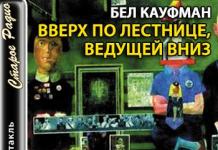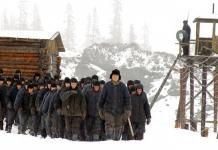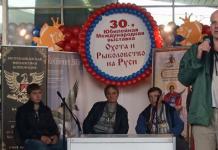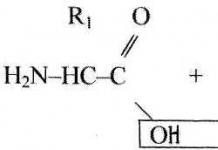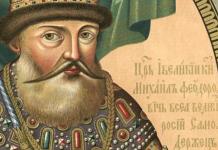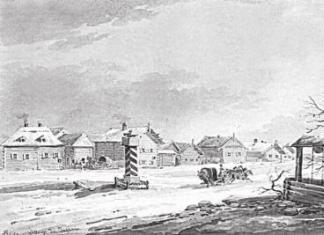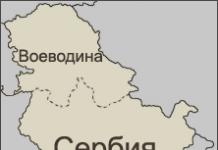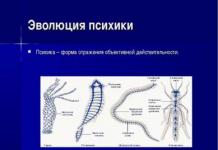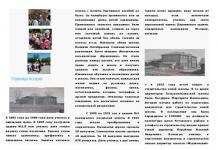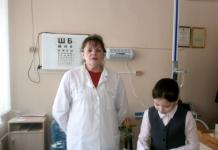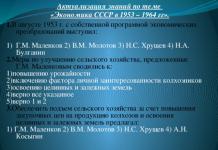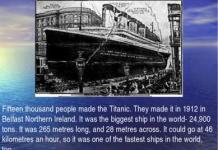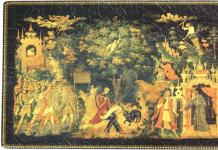60 years ago, on June 6, 1956, by a decree of the Council of Ministers of the USSR of June 6, 1956, tuition fees in senior classes of secondary schools, in secondary specialized and higher educational institutions of the USSR were canceled.
Contrary to popular belief that education in the USSR was free, this was not always the case. On October 26, 1940, Decree No. 638 "On establishing tuition fees in senior classes of secondary schools and in higher educational institutions of the USSR and on changing the procedure for awarding scholarships" was introduced. Paid education with a fixed annual fee was introduced in high schools and universities. Education in the capital's schools cost 200 rubles a year; in the provincial - 150, and for training at the institute already had to pay 400 rubles in Moscow, Leningrad and the capitals of the Union republics, and 300 - in other cities.
The amount of tuition fees at school and university was not high, the annual fee approximately corresponded to or was less than the average monthly nominal salary of Soviet workers. The average salary of a worker in 1940 was about 350 rubles. At the same time, the level of mandatory monthly expenses (rent, medicine, etc.) was lower than, for example, at present. By the Decree of the Council of Ministers of the USSR of June 6, 1956, tuition fees in senior classes of secondary schools, in secondary specialized and higher educational institutions of the USSR were canceled.
The formation of the Soviet education system
Soviet authority gave the education of the population a huge, actually leading role. Vladimir Lenin saw in the socialist revolution an opportunity to quickly overcome the economic and cultural backwardness of the country. The Cultural Revolution included a wide range of tasks of socialist construction in the field of culture. The school was assigned a special role as an educational institution and an instrument of communist education. It was not for nothing that Lenin declared at the congress of workers of education: “Only the school can consolidate the victory of the revolution. The upbringing of future generations consolidates everything that has been won by the revolution. "The fate of the Russian revolution directly depends on how soon the mass of teachers will take the side of the Soviet government." Thus, the Bolsheviks quite correctly and accurately defined the role of the school in the Soviet project. Only masses of educated and technically literate people could build a socialist state.
Prominent figures of the RCP (b) were placed at the head of the school affairs: N. K. Krupskaya, A. V. Lunacharsky, M. N. Pokrovsky. A. V. Lunacharsky headed the People's Commissariat of Education (Narkompros) until 1929. It should be noted that the first stage of the existence of the Soviet education system was associated with the destruction of the old education system and the elimination of illiteracy of the population. The former structures of school management were destroyed, private educational institutions, spiritual educational institutions, the teaching of ancient languages and religion was prohibited, the universal and domestic ones were withdrawn from the program. A “purge” was carried out to screen out unreliable teachers.
It is worth noting that at this time the so-called. Trotsky-internationalists are very "frolic", destroying Russian culture, education and history. It was believed that everything that was under tsarism was outdated and reactionary. Therefore, along with such positive phenomena as the elimination of illiteracy, private education and the influence of the church on schools, there were many negative ones. In particular, they refused to teach history, all the tsars, generals, etc., fell into negative figures, removed Russian classics from the programs, and many others. other. It is not for nothing that in the 1930s (during the period of Stalinism) much that was positive in the field of education in the Russian Empire was restored, including separate education for boys and girls.
It is also worth remembering that the First World War and the Civil War caused great damage to the public education system and the spread of literacy. National economy was in ruins. Due to the lack of funds, many schools were closed, and the number of students decreased. The remaining schools were in disrepair, there was not enough paper, textbooks, and ink for the students. Teachers who had not been paid for years were leaving schools. Full funding for the education system was restored only by 1924, after which spending on education grew steadily. So, in 1925-1930. spending on public education amounted to 12-13% of the budget.
The ways of forming a new school were determined in the documents adopted in October 1918: "Regulations on a unified labor school" and "Basic principles of a unified labor school (Declaration). The Soviet school was created as one system joint and free general education with two stages: the first - 5 years of study, the second - 4 years of study. The right of all citizens to education, regardless of nationality, equality in the education of men and women, the unconditionality of secular education were proclaimed (the school was separated from the church). In addition, educational institutions were entrusted with educational and production functions (in the modern Russian Federation, these functions are practically destroyed).
Decree of the Council of People's Commissars of the RSFSR of August 2, 1918 "On the rules for admission to higher educational institutions of the RSFSR" proclaimed that every person who has reached the age of 16, regardless of citizenship and nationality, gender and religion, was admitted to universities without exams, it was not required to provide a document on secondary education. The advantage in enrollment was given to workers and peasants, that is, the main social groups country.
The fight against illiteracy was proclaimed as a top priority. On December 26, 1919, the Council of People's Commissars adopted a decree "On the elimination of illiteracy among the population of the RSFSR", according to which the entire population from 8 to 50 years old was obliged to learn to read and write in their native or Russian language. The decree provided for the reduction of the working day by 2 hours for students with the preservation of wages, the mobilization of the literate population in the order of labor service, the organization of registration of the illiterate, the provision of premises for classes of educational program circles. However, during the years of the Civil War, this work could not be fully deployed. In 1920, the All-Russian Extraordinary Commission for the Elimination of Illiteracy (existed until 1930) under the People's Commissariat of Education of the RSFSR was established. In 1923, a mass society “Down with illiteracy” was created under the chairmanship of M.I. Kalinin, a plan was adopted to eliminate illiteracy of people from 18 to 35 years old in the RSFSR by the 10th anniversary of Soviet power. The Komsomol and trade unions joined the fight against illiteracy. However, this plan was also not fully implemented. Not enough staff material base etc. First of all, it was necessary to strengthen the main link of education - the school, in order to cover all children. Thus, the problem of illiteracy was solved in a natural way.
In the second half of the 1920s, education emerged from the crisis. The country is recovering after two wars and economic devastation, regular funding for education begins. So, in the 1927-1928 academic year, the number educational institutions compared with 1913, it increased by 10%, and the number of students - by 43%. In the 1922-1923 academic year, there were about 61.6 thousand schools in the country, in the 1928-1929 academic year their number reached 85.3 thousand. During the same period, the number of seven-year schools increased by 5.3 times, and the number of students in them doubled.
AT high school the new authorities tried to win over the cadres of the old, pre-revolutionary intelligentsia, and not without success, and to create new cadres from representatives of the working class and the peasantry. However, most of those accepted could not study at universities, since they did not even have a secondary education. To solve this problem, workers' faculties were established, created since 1919 throughout Soviet Russia. At the end of the recovery period, graduates of workers' schools made up half of the students admitted to universities. To create a layer of the new Soviet intelligentsia, spread the ideas of Marxism and restructure the teaching of social sciences, an extensive network of scientific and educational institutions was created: the Socialist Academy (since 1924 - Communist), the Communist University. Ya. M., Institute of K. Marx and F. Engels, Commission on the History of the October Revolution and the RCP(b) (Istpart), Institute of Red Professors, Communist Universities of the Working People of the East and National Minorities of the West.
As a result, the system of higher education took shape in its main features by 1927. Higher education institutions were tasked with professionally training specialist organizers. The number of precocious universities that opened immediately after the revolution was reduced, student enrollment was significantly reduced, and entrance exams. The lack of funds and qualified teachers held back the expansion of the system of higher and secondary special education. By 1927, the network of higher educational institutions and technical schools of the RSFSR consisted of 90 universities with 114.2 thousand students and 672 technical schools with 123.2 thousand students.
In the 1930s, the second stage in the creation of the Soviet education system began. In 1930, the resolution of the Central Committee of the All-Union Communist Party of Bolsheviks “On universal compulsory primary education” was adopted. Universal compulsory primary education was introduced from the 1930-1931 academic year for children 8-10 years old in the amount of 4 classes; for teenagers who have not passed primary education, - in the volume of accelerated 1-2-year courses. For children who received primary education (graduated from school of the 1st stage), in industrial cities, factory districts and workers' settlements, compulsory education was established at a seven-year school. School expenses in 1929-1930 increased more than 10 times compared to 1925-1926 academic year and continued to grow in subsequent years. This made it possible during the years of the first and second five-year plans to expand the construction of new schools: during this period, about 40,000 schools were opened. The training of teachers has been expanded. Teachers and other school workers were given a salary increase, which became dependent on education and work experience. As a result, by the end of 1932, almost 98% of children aged 8 to 11 were enrolled in studies, which solved the problem of illiteracy. Work continued on the elimination of illiteracy, which already gave better results.
In the early 1930s, the content and methods of teaching at school changed. have been reworked school programs, new stable textbooks have been created, the teaching of general and national history. The main form of organization educational process became a lesson, introduced a strict schedule of classes, internal rules. A stable school system with successive stages has developed. A new generation of teachers, talented and conscientious, who love children and their profession, has come to schools. It was these teachers who created the famous Soviet school, the best in the world and which is still a source of innovation for the most effective school systems West and East.
At the same time, a system of engineering, agricultural and pedagogical educational institutions was created, which allowed the Union to become a "superpower", which successfully opposed the entire Western civilization for several decades.
In 1932-1933. traditional, time-tested teaching methods were restored, specialization in universities was expanded. In 1934, the scientific degrees of candidate and doctor of sciences and the academic titles of assistant, associate professor and professor were established. That is, under Stalin, in fact, classical education was restored. Correspondence and evening education has been created in universities and technical schools. At large enterprises, educational complexes became widespread, including technical colleges, technical schools, schools, and advanced training courses. Total number institutions of higher education in the RSFSR in 1940 amounted to 481.
In the 1930s, the composition of the student body changed radically, which was facilitated by various training courses for young workers and peasants in universities, workers' schools, and recruitment of thousands of party members during the first five-year plans. The number of intelligentsia grew very rapidly; by the end of the 1930s, the new replenishment of this layer amounted to 80-90% of the total number of intelligentsia. It was already the socialist intelligentsia. Thus, the Soviet government created a third social support for itself - the socialist intelligentsia, largely technical. It was the basis and powerful support of the socialist, industrial state, the Red Empire. And the years of the terrible Great Patriotic War confirmed the advanced significance of the Soviet school, its effectiveness when soviet soldiers, commanders, workers, scientists and engineers brought up and educated in new system, defeated the most effective capitalist system - the Third Reich.
It must be said that our enemies perfectly understood the danger of the Soviet school. For example, during the war years, only on the territory of the RSFSR, the Nazis destroyed about 20 thousand school buildings, a total of 82 thousand in the country. In the Moscow region, by the summer of 1943, 91.8% of school buildings were actually destroyed or dilapidated, in the Leningrad region - 83 .2%.
However, even during the hardest war, the Soviet government tried to develop the education system. During the war years, government decisions were made on school education: on the education of children from the age of seven (1943), on the establishment general education schools working youth (1943), on the opening of evening schools in rural areas (1944), on the introduction of a five-point system for assessing the progress and behavior of students (1944), on the establishment of final exams at the end of elementary, seven-year and secondary schools (1944), on awarding gold and silver medals for distinguished secondary school students (1944), etc. In 1943, the Academy was established pedagogical sciences RSFSR.
Since 1943, the restoration of the higher education system began. Thus, in the conditions of war since 1941 admission to universities was reduced by 41%, compared with peacetime; the number of universities decreased from 817 to 460; the number of students decreased by 3.5 times, the number of teachers decreased by more than 2 times; girls were attracted to higher education institutions to keep the contingent of students; due to compaction, the terms of study were reduced to 3-3.5 years, while many students worked. As a result, by the end of the war, the number of higher educational institutions and the number of students approached the pre-war level. Thus, the crisis of higher education was overcome in the shortest possible time.
It is worth noting that large sums were invested in education in the post-war period. In addition, collective farms, trade unions, and industrial cooperatives allocated money for school construction. 1,736 new schools were built in the RSFSR alone by the efforts of the population using the method of people's construction. By the beginning of the 1950s. The Russian school not only restored the number of educational institutions, but also switched to universal seven-year education.

About paid education under Stalin
After the destruction of the Soviet, socialist state in 1991 - the bourgeois-oligarchic revolution, where a significant part of the Soviet nomenclature, especially the highest, acted as the bourgeois class, the Russian Federation, in fact, became a semi-colony of the West (and partly of the East). It is clear that in a semi-colony or in a country of peripheral capitalism it is not necessary to have an education system that gives hundreds of thousands of pretty good educated people(and compared to the average level of the West and East, not to mention Africa or Latin America, just great). After all, sooner or later they will start asking questions, expressing doubts about the success of the “reforms”. Therefore, the gradual demolition of the Soviet school began with the transformation ordinary schools in the American analogue for commoners: "prison romanticism" (guards, cells, fences, etc.); refusal of educational, productive functions; reduction of hours of fundamental disciplines with the introduction of unnecessary lessons such as world culture, local languages, "God's law", etc.; translation into a second language - English (the language of the Anglo-American world order), which ultimately leads to the creation of an ideal consumer-performer. At the same time, kindergartens and schools are gradually “capitalized”, that is, they are transferred to a paid basis. The children of the rich and "successful" get the opportunity to study in private elite schools in the Russian Federation or send their children to similar institutions abroad. That is, the people were again divided into two unequal parts, and the gains of socialism are being destroyed.
However, for this it was necessary to bring a certain ideological base. It was necessary to prove that the Soviet education created only "sovki" with totalitarian, militarized thinking. And how can one not remember that Stalin introduced "paid education"! Like, already under Stalin, a significant percentage of the population was cut off from the opportunity to continue education.
Actually it is not. First, we must remember that the Bolsheviks created a secondary school in general, and it remained free for everyone. It was a huge work: capital investments, personnel, a vast territory, dozens of nationalities and many others. other. Universal primary education was established with great difficulty by the end of the 1920s. The total average - by the mid-1930s. In the 1930s, they created the basis for the best education in the world. And preparatory education for higher educational institutions (three senior classes), for which fees were introduced, in 1940 was only in its infancy. The introduction of tuition fees in high school, in fact, was the reason that the newly introduced social good did not have time to master. Second World War was already in full swing, the terrible Patriotic War was approaching. Soviet Union intensively engaged in preparations for it, so plans for the speedy introduction of a higher free education had to be postponed.
Quite rational decision. At this moment, the Union needed more workers than representatives of the intelligentsia, taking into account the already created personnel base. In addition, military educational institutions were still free and seven-year schools stimulated the creation of a Soviet military elite. Young men could go to flying, tank, infantry and other schools. In the context of the war, this was state wise.
It is also worth noting that under Stalin they built a healthy hierarchy. At the top of the social ladder was the military, scientific and technical, educational (professorship, teaching staff) elite. Compulsory education was seven years, then dropping out through exams and the decision of the school's teachers' council. The rest is either according to the most severe competition, or in the direction of the competent organizations. At the same time, everyone had the opportunity to rise higher, talent and perseverance were needed. The armed forces and the party were powerful social elevators. Another important element of this system was the separate education of girls and boys. Given the psychological and physiological differences in the development of boys and girls, this was a very important step.
After Stalin, this healthy hierarchy, which they began to build, was destroyed by “leveling”. And since 1991, a new estate has been built (within the framework of the general archaization of the planet and the onset of neo-feudalism) with a division into rich and “successful” and poor, “losers”. But here there is a hierarchy with a “minus” sign: at the top of the social ladder is a non-producing class, the capitalists are the “new feudal lords”, usurers-bankers, corrupt officials, mafia structures that serve their strata.
As a result of this decision and the subsequent tragedy of the Great Patriotic War, there was some slowdown in the shock rates of the spread of public education. It should be noted that it was temporary, and the abandonment of measures to introduce paid education occurred immediately after the end of the war and post-war period restoration of the country.
As soon as the recovered state could afford the development of industries related not only to the needs of the current survival, it immediately did so. At the same time, one must understand that paid education from 1940 to 1956 was not an analogue of European paid, elite higher and secondary education that cut off educational services and knowledge.
As historians and researchers of the Soviet period point out, the amount of 150 rubles a year for schools and secondary educational institutions and 300 rubles a year for universities in most cities and villages of the country was not something unbearable.
Historians report that the average salary of a worker in 1940 was 300-350 rubles per month. Whereas the amounts of 300-400 rubles for education at universities were intended for annual education. Even if the indicated average salary is, one way or another, overstated, and in reality an ordinary worker or peasant could receive only 200 or even 100 rubles a month, all the same, the indicated tuition prices do not look unbearable.
Yes, for the population of a poor country, this money was not at all superfluous, and not all families had good salaries. For example, for the peasantry, these measures really created serious problems in social mobility. However, here we must understand that the Soviet authorities deliberately for a long time restrained the possibility of horizontal mobility of the inhabitants of the villages, keeping them in the collective farms.
With this article, I open another cycle. The phrase "this was not the case under Stalin" has long become a catchphrase. It applies to both positive and negative phenomena. Indeed, much of what now seems ordinary, at first glance, is not applicable to those times. And vice versa. Is it so?
Theorists of socialism considered commodity-money relations to be evil. Heavenly. But, unfortunately, there is still no alternative on a global scale. This was confirmed by the experiments of practical socialists in the early 1920s. At that time, attempts to exclude the depreciated money supply from circulation and switch to a system of gratuitous distribution of products, services, tangible property almost led to the second round civil war. And the money returned to all spheres of public life. Until the 1960s, in the USSR, the population independently paid for a huge number of services that were later recognized as publicly available. Medicine, education, social and cultural life were partially self-supporting. Today we will talk about pre-war education.
After the revolution, the education system was recognized as the most important industry. Private schools were banned, the principle of free education was introduced. However, already in 1923, a decree was issued, allowing to regulate the issue of payment on the ground - in cities and towns. The categories of "free students" were envisaged, their number in schools was not to be less than 25%. It was forbidden to charge preschool institutions and institutions of lower vocational education. A special procedure for paid education in universities was determined. In 1927, partial tuition fees were extended and the list of such institutions expanded. At that time, the issue was decided in each case individually, there were both completely free and highly commercialized institutions. There were no uniform rates. Payment was calculated based on family income. For the poor, it was 1% of earnings in schools and kindergartens, 1.5% in technical schools, 3% in universities. From the wealthy they took 3%, 4%, 5% of earnings, respectively. Even more difficult was the calculation for peasants and handicraftsmen.

In pre-war Belgorod, public schools were free. In addition to them, there were 3 schools and 6 kindergartens, which were on the balance sheet of the South Railway, the children of railway workers studied in them, all expenses were paid by the department itself. However, paid professional courses, advanced training, additional education, teaching music, arts, private lessons, services of educators were practiced very widely.

Since 1940 the situation has changed. A government decree on universal paid education in high school, technical schools and universities is being adopted. The rationale is simple: the well-being of the population has increased, spending on education and science has risen sharply. Indeed, the pace of construction and the level of equipment of educational institutions increased greatly in the second half of the 1930s. At this time, every year (!) In Belgorod, built and put into operation new school, the network of secondary schools and trade schools was expanding, and in 1939 a teacher's institute was opened.

How did society react to the innovation? Certainly negative. Propaganda kicked in. This is how citizens were explained the benefits of unexpected expenses:

The cost of education in grades 8-10 in secondary schools in Belgorod was 150 rubles. in year. The same amount was paid by students of technical schools, pedagogical colleges, vocational schools, medical schools. Is it a lot or a little? The average salary in the country then was about 300 rubles. And although the spread in income was not as huge as it is now, the majority of Belgorod residents actually received no more than 150-200 rubles. The reason is the underdevelopment of industry. The most wealthy among respectable citizens were the Stakhanovites, for example, on railway and factories could then receive 600 or more rubles. There are examples of Belgorod machinists earning more than 1.5 thousand rubles a month in 1939-1940. In general, the payment for a year of school was approximately equal to the monthly salary of one of the parents.
The tuition fee at the teacher's institute was set at 300 rubles. in year. According to the decision of the Council of People's Commissars, students, including senior students, who did not pay for the current semester by November, were automatically expelled. Students of evening schools, correspondence students of universities, secondary vocational schools and courses paid half the usual cost. At the same time, there was a rather significant list of beneficiaries-schoolchildren who studied free of charge: orphans, children of the disabled, low-income, etc. Students from among the needy could apply for a state scholarship, which paid for professional education. In addition, the usual scholarship could also cover the cost of payment, for which it was necessary to have at least two-thirds of excellent grades and a third of good ones. A number of educational institutions continued to provide free hostel.

Paid education in the USSR was abolished in 1956. Against the background of a further increase in gratuitous social benefits of the subsequent period, the described approach looks strange. But the pre-war country was filled with contrasts, sometimes more than now. More on this in the sequel.
From rumors about the reform of education, citizens, of course, greatly tensed up. I myself tensed up, although I understood that sooner or later this would happen: it’s not good to have so many educated people under peripheral capitalism. However, part of the citizens, from among not comrades, of course, began to look for ways to prove that, they say, this is not bad, but even good. Or at least not worse than before. Moreover, by "before" it would be desirable to understand the USSR. For the subconscious mind tells you: if with sausage in the USSR, perhaps, not everything was chocolate, pardon the pun, then with education ...
In general, we urgently need to prove that in the USSR everything was bad with education. So that the reform at least does not look like an unprecedented drain of everything and everything. Well, here, how not to remember: under Stalin, there was also paid education !!! Well, like, "your beloved Stalin is even worse, yes." Well, or, as an option, "and they are following in the footsteps of your beloved Stalin."
Some even found the relevant resolution and joyfully posted it. With idiotic, as usual, comments. View: and this cattle was cut off from education on purpose. It is not entirely clear, however, how the citizens cut off from education regularly flowed from the village to the cities to the factories, and where such a number of scientists and engineers came from - perhaps less than in several of the most developed countries of the world, but certainly more, than in the Russian Empire. Although such questions should not bother freethinkers. Contradictions only confirm the correctness of the theses.
For example, the Nazis regularly prove to the Communists that October Revolution was Jewish. At the same time, the liberals prove to the communists that the Bolsheviks were specifically engaged in the extermination of the Jews and, in general, bred unbridled anti-Semitism. It would seem, what are you proving to us? You have a clear contradiction with each other: theses are deployed one hundred and eighty degrees. But no, Nazis and liberals do not argue among themselves on this topic. This is strictly for a dispute with the communists.
So, here's the ruling. It means they put it out. It means it exists. In the free, means, access. Let's count?
No. 27 of October 26, 1940
Decree No. 638. (pp. 236-2374 237-238).
pp. 236-237
"On the establishment of tuition fees in senior classes of secondary schools and in higher educational institutions of the USSR and on changing the procedure for awarding scholarships."
Taking into account the increased level of material well-being of the working people and the significant expenditures of the Soviet state on the construction, equipment and maintenance of a continuously growing network of secondary and higher educational institutions, the Soviet People's Commissars The USSR recognizes that it is necessary to lay a part of the costs of education in secondary schools and higher educational institutions of the USSR on the working people themselves, and in this connection decides:
1.Introduce from September 1, 1940 in the 8th, 9th, and 10th grades of secondary schools and higher educational institutions tuition fees.
2. Establish the following tuition fees for students in grades 8-10 of secondary schools:
a) in schools in Moscow and Leningrad, as well as in the capital cities of the Union republics - 200 rubles per year;
b) in all other cities, as well as villages - 150 rubles per year.
Note. The specified tuition fees in grades 8-10 of secondary schools shall be extended to students of technical schools, pedagogical colleges, agricultural and other special secondary institutions.
1. Establish the following amounts of tuition fees in higher educational institutions of the USSR:
a) in higher educational institutions located in the cities of Moscow and Leningrad and the capitals of the Union republics - 400 rubles per year;
b) in higher educational institutions located in other cities - 300 rubles per year ...
Chairman of the Council of People's Commissars USSR V. Molotov
Manager of the Affairs of the Council of People's Commissars of the USSR M. Kholmov
Moscow Kremlin. October 2, 1940 No. 1860.
First of all, we are surprised to find out that this is not Stalin, this is Molotov. But that’s not the point, it’s clear to everyone that Stalin was personally in charge of all issues in the country, and Molotov was his six. However, other surprising things are also revealed. It turns out that paid education was introduced, but not all education became paid. The secondary school, as it was free, remained. Moreover, for the entire population of the USSR. Moreover, there was simply no such school before the Bolsheviks. Before the Bolsheviks, the only education accessible to all was parochial schools, where they taught reading, writing, simple arithmetic, and the law of God. At the same time, approximately every second person, according to the results, did not even have such skills.
Under the Bolsheviks, the situation changed radically, and by the notorious 40th, there were less than ten percent of the population illiterate. At the same time, a significant part of the literate not only knew how to read and write, but had an average or higher education.
That's why it's impossible to say "but Stalin did the same." No, the collective “Stalin” brought the catastrophically illiterate population to the level of literacy of the leading states of the world.
But still, what about the board? It's serious to do free education paid!
There's a subtlety here. As already mentioned, “Stalin” made paid education, which he himself created. Moreover, he created it recently - the current reformers got a system in which free higher education has existed for half a century.
Universal primary education was established by the end of the twenties. The general average - by the mid-thirties. From which, as you might guess, it follows: preparatory education for higher educational institutions (those same three senior classes) in 1940 was only in its infancy. It can in no way be considered a long-standing one, which suddenly suddenly became paid. Actually, the thirties were the period of the formation of the school, and, moreover, a very rapid formation. And the introduction of tuition fees in high school, in fact, was the reason that the newly introduced social benefit simply could not be mastered with a swoop. After all, we must remember that in the late thirties it became quite obvious: there will be a war. The country was intensively preparing for it, so plans for the speedy introduction of higher free education also had to be postponed.
After the war and the reconstruction period, higher education also became free.
The resolution stipulates, among other things, the amount of payment. For senior classes 200 rubles per year in the capitals and 150 in other places. For universities 400 rubles per year in the capitals and 300 outside them. Is it a lot or a little?
The average salary of a worker in 1940 was about 350 rubles. Per month. Not in a year. In a month for the education of one child in high school, thus, the worker gave 200 / (350 * 12) = 1/21 of the average salary. That is, by today's standards, it is 850 rubles. For studying at the institute - one tenth. Is it a lot or a little? There are nuances here. Now that's a lot. Then it's not enough. Why is that? Because the level of mandatory monthly expenses is also important - rent, medicine, etc. It is they who determine what percentage of the salary is "free money" - those whose spending can be varied.
Tellingly, everyone understands that now they will take not 850 rubles at all as payment. 850 rubles now - one visit to a doctor in a paid clinic. To the therapist - not to the expert.
So, yes, compare the collective “Stalin”, who rebuilt the education system almost from scratch and offered to temporarily pay for its uppermost fragment on rather mild terms, and then only on the eve of big war, with modern reformers who dream of paying for even primary education, which goes beyond the framework of the parochial school, to whom the entire education system has already been in fifty years as a finished product.
Tuition fees in senior classes of secondary schools and universities of the USSR were abolished by a government decree on May 10, 1956. It was introduced in October 1940. In fact, Stalin at that time began the formation of a new estate, and the workers and peasants lost their "social ladder" ...
On October 26, 1940, Decree No. 638 "On establishing tuition fees in senior classes of secondary schools and in higher educational institutions of the USSR and on changing the procedure for awarding scholarships" was introduced. Paid education was introduced in high schools and universities with a fixed amount of annual payment.
Education in the capital's schools cost 200 rubles a year; in the provincial - 150, and for studying at the institute already had to lay out 400 rubles in Moscow, Leningrad and the capitals of the union republics, and 300 - in other cities. 
The annual payment roughly corresponded to the average monthly nominal salary of Soviet workers at that time: in 1940 it was 338 rubles per month.
However, the introduction of even such a modest fee for many Soviet citizens closed the opportunity to continue education after the 7th grade. And then the collective farmers did not receive wages at all and worked on the collective farm for workdays. 
As a result of the "reforms" carried out, the number of graduates of secondary schools (grades 8-10), secondary specialized educational institutions and universities has halved. The Soviet government deliberately sought to limit the number of people with secondary, secondary specialized and higher education. The country needed people at the machine. And this was achieved by measures of an economic nature: tuition fees were set.
In fact, Stalin at that time began the formation of a new estate. The same peasants could not "get out into the people" even through studying at a technical school, and the workers - through a university. Recall that in the families of that time, the norm was 5-7 children for peasants and 3-4 for workers. And paying for the education of 2-3 children was an unbearable burden for them. 
At the same time, at the end of 1940, the regulation “On the State Labor Reserves of the USSR” appeared. The Council of People's Commissars received the right to annually call up from 800,000 to 1 million urban and collective farm youth, starting at the age of 14, to schools and factory training schools (FZO).
Graduates received referrals to enterprises where they were required to work for 4 years. And later, a decree appeared on criminal liability for up to 1 year "for unauthorized leaving or for systematic and gross violation of school discipline, resulting in exclusion" from the school (school). In fact, the state attached students to the FZO. 
(In the photo: an advanced group of students - carpenters of the school of FZO No. 7 in Leningrad)
The only social ladder for the lower classes then became military schools - education in them was free. Or after serving in the army - work in the NKVD.
But even under Khrushchev, school education actually had to be paid. On December 24, 1958, the law "On Strengthening the Link between School and Life" was adopted, introducing a compulsory eight-year education. But at the same time, students in grades 9-10 had to work 2 days a week in production or in agriculture- everything that they produced during these 2 days of work at the factory or in the field went to pay for school education.
For admission to a university, work experience of at least two years after graduation was now required. This “school reform” was canceled immediately after the dismissal of Khrushchev, and school education finally took on a modern look only under Brezhnev, in 1966. 
Against the background of Stalinist serfdom and estates, "experiments" with school education Khrushchev and current politicians, the “Brezhnev” time for Russians should seem like Paradise. However, surprisingly, no one remembers Brezhnev ...


